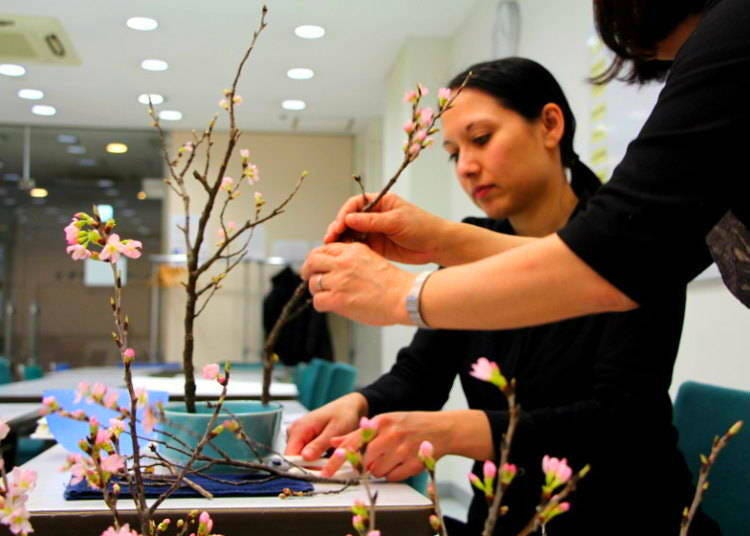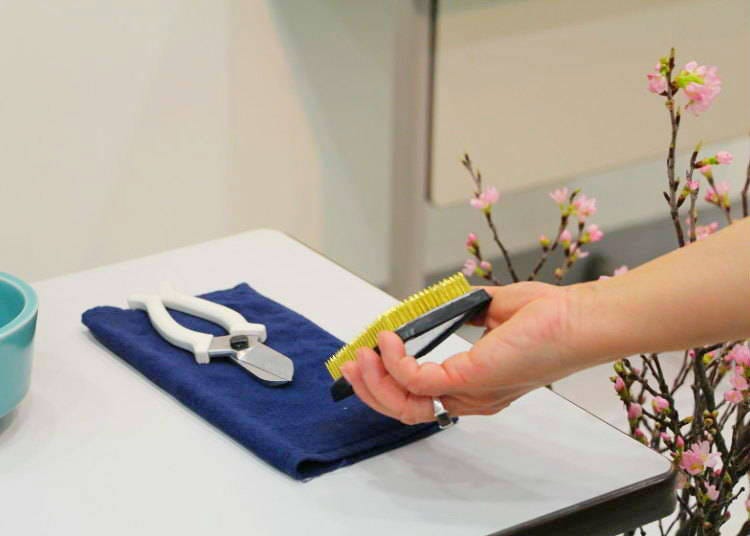
Learn the Art of Flower Arrangement at Ohara School of Ikebana
- Written by: Holly Neslusan
Ikebana, flower arrangement, is one of Japan’s most treasured art forms, a time-honored tradition that continues to be relevant even in today’s modern society. Beautifully arranged flowers and plants have permeated Japanese culture in a way that is seldom found in others. The Ohara School of Ikebana has played a major part in keeping the tradition alive, through its many schools in Japan, as well as its 59 chapters abroad, with over 300,000 members worldwide.
The beauty of the Ohara School is not only in its floral arrangements, but its ability to share the culture of ikebana with the world. I visited the Ohara Center of Tokyo to try an ikebana class to learn more about this traditional art form.
Ikebana Basics

Ikebana has a history dating back over 600 years, with roots in the ritual Buddhist floral offerings known as ‘kuge’ using the branches of what were believed to be sacred evergreens. By the mid-fifteenth century ikebana was an established art form of its own accord, artistically implementing various forms of plant life including flowers, moss, leaves, branches, or even fruit in various forms of containers. To master ikebana requires a level of expertise that relatively few are able to achieve.
Ikebana is not only focused on the plants themselves, but the empty space around the plants. To create an arrangement that is both beautiful, but unseen in nature, is one of the main themes of ikebana.
About Ohara School of Ikebana

The Ohara School of Ikebana was founded in the late nineteenth century by Unshin Ohara. This was around the time when Japan had begun opening up to Western influences, which also influenced ikebana as well. The two main types of ikebana used by the school are Moribana and Heika. Moribana is a type of ikebana in which plants are arranged in low, wide containers called Suiban. With Heika, tall, cylindrical vases are used to arrange the plants.
Unshin created the signature expression of the Ohara School known as Moribana, as well as Suiban that is used for this type of ikebana. A particular specialty of the school is Landscape Moribana, which focuses on the various elements that can be found within nature to represent natural landscapes. For example, a pond themed Landscape Moribana may include water, reeds, and lilies.
Throughout the years, different Headmasters (all of whom are descendants of Unshin Ohara) incorporated different styles into the school. Houn Ohara, the third Headmaster introduced the Bunjin arrangement that takes advantage of the material’s symbolic properties, as well as Rimpa arrangement, based on the painting style of the same name. Fourth Headmaster Natsuki Ohara created the two modern expressions known as Hanamai and Hana-isho. The current Headmaster, Hiroki Ohara, created Hana Kanade, a new expression that also broaches the theme of the contemporary lifestyle.
From Wildflowers to Ikebana

Despite having little more than a passing knowledge of the subject of ikebana, I’ve always admired it from an observer’s standpoint. Flowers, trees have long held my fascination, ever since growing up in a small, rural area, where I often spent my free time playing in the forest, or tending to plants in the small family garden. These days, I make a point to visit parks frequently, so that I enjoy nature, even while living in Tokyo. However, while I often stop to smell the roses, both figuratively and literally, I only seldom have the chance to view the expertly arranged ikebana pieces. While certainly beautiful to look at, I imagined that the creation of ikebana remained strictly within the realm of experts. I was both surprised and happy to learn that there was a place that welcomed beginners and non-Japanese to try their hand at the art form.
Moribana and the Geometry of Flower Arrangement

I visited the Ohara School of Ikebana to take one of their flower arrangement lessons offered in English. I met my ikebana sensei for the morning who invited me to take a seat in the spacious classroom. We began with a brief explanation on ikebana, after which she introduced me to the style of Moribana, the arrangement that utilizes a wide, shallow container. I was even given a paper handout explaining the three types of Moribana: water reflecting style, slanting style, and upright style, each of which require the objects be placed according to their own geometric specifications that create a scalene triangle.
The moribana that we would be creating would be in the upright style, which is the most standard. Prior to this lesson I had no idea that the flowers used in ikebana were placed at specific designated angles. Another facet that is central to Moribana is the use of three principle stems: the subject, the secondary, and the object. In Japanese, these are called ‘shu-shi,’ ‘fuku-shi,’ and ‘kyaku-shi,’ respectively.
Spring Flowers and Ikebana Tools

Placed before me was the shallow ceramic container characteristic of moribana. I also had a pair of special ikebana scissors, a bowl of water, and a ‘kenzan,’ which is the metal holder of the plants used in ikebana.

Moribana typically expresses some kind of theme, and my arrangement was no different. The sensei decided that the theme of the day was “spring,” and brought out several cherry blossom branches and also some irises, both of which are representative of the upcoming season.
Selecting the Stems

It was time to begin the arrangement. Cherry Blossoms were to be the subject, but first I had to choose which branch. While I am sure there are a number of factors that are considered by ikebana experts, the sensei told me that part of the selection process is using your own personal feeling. I decided on a branch which I then cut to a more manageable size. I was instructed to make a cross-cut at the bottom to make it easier to place into the kenzan.
Artistic Arrangement

After the initial placing of the cherry blossom branch, I was told that I should remove some of the branches. While it was hard to say goodbye to any of the pink blossom covered branches, I understood that empty space too is an important part of ikebana. I continued the selection process with the secondary and object, both irises. The provided bowl of water was for trimming the flowers in. The sensei showed me just how to angle the plants to make a scalene triangle that follows the upright style.

We opened two of the iris petals using our fingers–a technique that I had never before considered. The result was a flower that appeared to be in peak bloom. However, it was suggested that the flower of the third iris remain closed, which did make for an interesting final aesthetic.
Finishing Touches

At last my ikebana arrangement was complete. A beautiful and unique spring-themed moribana of my very own! Anyone interested create their own flower arrangement at the Ohara School of Ikebana can refer to the school’s official homepage for information on lessons, in English and Japanese, at the Ohara Center in Tokyo, or through one of their international chapters.
-
Ohara School of Ikebanaいけばな 小原流
- Address 5-7-17, Minami Aoyama, Minato-ku, Tokyo 107-8607
After growing up in Massachusetts, Holly headed to Japan in search of new adventures and green tea. She ultimately made her way to Tokyo, where she enjoyed exploring and writing.
- Area
- Category
*Prices and options mentioned are subject to change.
*Unless stated otherwise, all prices include tax.
Popular Tours & Activitiess
Recommended places for you
-

These Tokyo Subway Stamps Are Free, Exclusive, and Weirdly Addictive
by: Guest Contributor
-

New in Ginza! Air BicCamera Ginza Opens with a Faster, More Convenient Shopping Experience
by: Guest Contributor
-

Jujutsu Kaisen Takes Over JR East With a Wrapped Shinkansen This Winter
by: Guest Contributor
-
Ad

Discover the "Miraculous Forest" in the Heart of Tokyo: The Institute for Nature Study (9 Minutes from JR Meguro Station)
-

This Winter, Godzilla Takes Over Haneda Airport
by: Guest Contributor
-

Make Your Japan Trip Unforgettable! Explore "OSHI MAP" – Now Free and Unlimited
by: Guest Contributor
Inspiration for Accommodations
-

Enjoy Mt. Fuji from the Comfort of Your Room! Recommended Ryokan with Mt. Fuji View
-

Stay Near the Cherry Blossoms! Hotels for Cherry Blossom Viewing in Tokyo
-

Family-Friendly Hotels with Free Shuttle to Disneyland: Convenient Access for a Magical Stay
-

Top Ranked Hakone Hotels with Mt. Fuji View: Enjoy Stunning Scenery from Your Private Space
-

Convenient Tokyo Hotels with Airport Shuttle: Ideal for Families and Heavy Luggage
-

Stunning Tokyo Tower View Hotels: Enjoy Spectacular Scenery from Your Private Space
-

Convenient Asakusa Hotels with Kitchens: Ideal for Extended Family Visits
-

Experience Luxury: Hakone's 10 Best Five-Star Accommodations
-

Enjoy Mt. Fuji Autumn Leaves! Top Hotels Near the Popular Autumn Leaves Corridor
-

Experience Hakone Fall Foliage from Your Room with Stunning Views
-

Ikebukuro Station Area Guide: Top 15 Spots When You Escape the Station's Maze!
-

Atami 1-Day Itinerary: Exploring Japan's Castle & Hot Springs Resort Town Near Tokyo!
-

Only in Tokyo? A Legendary Manga Artist's New Masterpiece Is Hiding Underground
by: Guest Contributor
-

6 Surprisingly Cheap Things in Japan
-

[MOVIE] Folding Fun at the International Origami Center
by: Holly Neslusan
-

Maneki Neko: The Lucky Cats of Japan
- #best ramen tokyo
- #what to buy in ameyoko
- #what to bring to japan
- #new years in tokyo
- #best izakaya shinjuku
- #things to do tokyo
- #japanese nail trends
- #what to do in odaiba
- #onsen tattoo friendly tokyo
- #daiso
- #best sushi ginza
- #japanese convenience store snacks
- #best yakiniku shibuya
- #japanese fashion culture
- #best japanese soft drinks



















